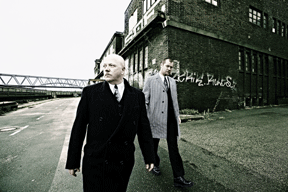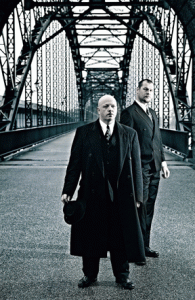By Jonathan Williams
With its latest album Automatic, electro-industrial act VNV Nation has created one of its most successful and forward-thinking works to date. Heavily inspired by the sleek art deco minimalism and optimistic spirit of the American ’30s, Automatic is a stylistic and thematic departure from previous albums while maintaining the signature sounds that singer Ronan Harris and drummer Mark Jackson have established for VNV Nation. Having just finished a massive European tour in support of the album, the band’s United States tour kicks off tomorrow with German electronic dance act Straftanz opening each show. Just before departing Ireland for the tour, Harris talks to Wrestling with Pop Culture about Automatic.
You just finished a European tour in support of Automatic and you begin your U.S. tour tomorrow. How have the shows been going so far?
I’m not lying when I say they’ve been going phenomenally well. The album came out at the beginning of September while we were on tour and we really put a lot into this tour. We started doing an extended set, so we’ve been playing anywhere from two-and-a-half to three hours, which really seemed to fly by. We played all over Europe and the reactions from fans and reviews have said this is the best tour we’ve done so far. We have a set that we think really kicks and we just played in Scandinavia last week and people were blown away, saying this was the best show ever. That’s not something you can intend to do, that’s not something you can plan to do, you just hope it works out. It seems to have paid off in spades. People are going nuts about it. It’s a very energetic show with ups and downs and it just keeps people going.
I understand you recorded this album a little differently than you’ve recorded previous albums. How did the Automatic process differ from other albums and how have you translated that to these live shows?
There are a lot of computers in our setup. We have two computers on stage, which are operated by the keyboardists, and they’re using sounds that are on the album. Sometimes it’s loops, sometimes it’s sounds and melodies, but we try to have as much playback live as is possible. There’s a computer system at the front of the house that has all the multi-tracks and all the other bits and pieces. This isn’t like playing a guitar and a bass, there’s a lot of weird little sequences, effects and loops. The drummer is playing a lot of the sounds from the album as well, so the whole thing together is as much as we can split off the actual recording and recreate live as is possible. Then there are a ton of videos and all kinds of fun stuff.
As far as the album production is concerned, there were things with the last album that I really wished I had done differently. That didn’t make it a bad album, I think it was one of our best albums. But I wanted to do something much, much bigger. I went for a very vibe-y sound on this album. There’s a lot of distortion and sort of harmonic overdrive being used on this album. I didn’t want it to saturate the whole thing down to sound like mud, so I spent a lot of time pre-thinking about how we do things, using a lot of state-of-the-art plug-ins. So I would predominantly concentrate on writing the songs and creating the sounds that I thought were fitting for this sound. It started to become very cohesive and everything I was creating for the album all seemed to fit together. There wasn’t going to be something that would stand out on the album and sound like it came from a completely different place. I wanted it to be everything from heavily energetic to soulful, but it always comes from the same space.
There are a lot of new sounds on the album, a lot of new styles that we would never use before. And we’ve basically taken a break from a lot of things we’ve used in the past to really give it new flavors. I guess a lot of underground electronic music has had an influence on me. There was a lot of sort of punky electronic music that had an influence on me as well. I wanted a very analog feel to this album, even though I’m using a computer, so everything was mixed through an analog device. The one thing that is always going to be there for every single album is the vocals, and it’s always going to be me singing, so we really concentrated on that. We’re not a band with massive amounts of equipment, so we concentrate on what’s important. I got the best microphones I could get for this. A lot of people might not understand why that’s really important, but when you hear the results on the album, that basically says it right there. This was leaps and bounds from what we did before as far as recording quality is concerned, and also the ability to mix things without having problems. We started out from the same point, I had a very strong idea of how I wanted the whole thing to feel and sound, then we concentrated on certain things in the right places.

Ronan Harris and Mark Jackson of VNV Nation look to the past for a better future on "Automatic." Photo by Ben Wolf
This album was also inspired by other pop cultural and historical sources. How would you say this album compares thematically to previous albums?
It was heavily influenced and inspired by the American ’30s. I do graphic design for people under another company name so it’s never tied to the band, but I do a ton of other work that I ended up involving in this project. The spirit of the American ’30s, which is something I’ve read vast amounts on and collected books and paraphernalia on, was a very unique period. Even though it was a period of only ten years, the world changed dramatically technologically and in the spirit of wanting to achieve. It was a period, as well, of economic crisis, which I found ironic as I started to reread a ton of books about two years ago. I really got back into this and have really immersed myself, and I found out that they were dealing with a lot of things that we’re dealing with today. What they had that we don’t have was the amazing sense of vision because they were trying to change the world to make it a better place. There were huge fairs and shows and a sense of naivete about the future. But the spirit of it was to make the world a better place, to make it easier for people, and it was all about individual effort. It wasn’t about being part of some massive organization or something like that, it really was about the individual’s creative output and expression.
As far as design is concerned, the ’30s was an incredible period because everything looks sexy. Any retro-futurist film is always going to borrow a huge amount from that era. A lot of the things I was writing were from a retro-futurist point of view and imagining everything within the look and feel of that era. I wasn’t going to do swing music or anything like that. But there’s a track on the album called “Streamline,” which encapsulates a lot of the philosophy of designers who were saying, “This is how the world could be and this is how we should approach it.” I wanted to express it’s naivete and style-wise the song is based on ’70s electronic futurist music, which was all about how great and automated this sci-fi world will be in 20 years. I wanted to combine the two because electronic music really began its commercial use in the ’70s. Before that it was pretty much test equipment or the toys of the very, very rich. People like the Beach Boys and the Beatles could use it, but they didn’t really know what they were doing with it aside from creating some neat weird noises. But the ’70s produced this ton of great artists who were writing cerebral and trippy music, and they invented ambient music and a ton of other things that are still evolving today. I wanted to capture a bit of that ’70s electronic futurism and marry it to this ’30s American futurism.
How that differs from previous albums is that I view this as an incredibly positive album. I think the last album I did that was roughly in this vein would have been Futureperfect in 2001, and that was about “Here we are 100 years later, what is different between the world at the turn of the 20th century and the turn of the 21st century?”. It was a very dark album, a very bittersweet album, in saying, “Where are all the visions? Where’s our get-up-and-go in wanting to make the future a better place?” This album is really about immersing yourself in that spirit and writing as though that were the vision of today.
You’re also heavily involved in the visual aspects of VNV Nation, which are always a big part of the shows. What have you been doing visually on this tour?
A couple of years ago we started to experiment with LED systems, but using them in a clever way. A lot of people will just build a wall and show an image. What we were doing was splitting the panels up in different places around the stage and using them all independent of one another, and using them both as visual media and as a groovy light show. It’s been honed and maximized, so I think it’s a very energetic stage show that doesn’t dominate the art that’s on stage. Some people have shows where they’re trying to push everything at the same time at the same level, but I want everything to fit in it’s right place. But I think we’ve really taken it up a notch.
For more information, go to www.vnvnation.com.

